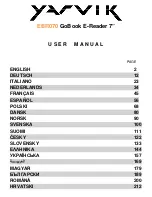
Chapter
4
Operating Instructions
CLV65x Bar Code Scanner
28
©
SICK AG · Division Auto Ident · Germany · All rights reserved
8011980/0000/2009-04-21
Product description
Tab. 4-3:
Overview of the bar code scanner's product features and functions
4.6
Bar code scanner's methods of operation
The CLV65x bar code scanner is an intelligent sensor system for automatic and non-contact
detection and decoding of bar codes. In principle, the codes can be detected on any side of
resting or moving objects in a conveyor system (
single-side reading
).
Several bar code scanners can be combined to allow detection of several sides in one pas-
sage (
multi-side reading
).
The bar code scanner creates a scanning line (
line scanner
) to recognise the codes.
Line scanner with oscillating mirror
The oscillating mirror additionally deflects the scanning line from the home position to both
sides, perpendicular to the scanning direction, with a low oscillation frequency. This enables
the bar code scanner to scan larger areas for bar codes as well.
The length of the scanning line that is used for the evaluation (reading area height) depends
on the reading distance because of the V-shaped light exit.
The light pattern that is reflected by the bar code is recorded, processed and decoded. To
control this process, external sensors deliver information via the reading pulse, the object
distance and the conveyor speed (increment). The reading results are output to the bar
code scanner's data interfaces and forwarded to a host/PC.
Electrical interfaces
• Host interface: RS-232, RS-422/485 (data format and protocol can be configured) and
Ethernet or CAN
• Aux interface: RS-232 (fixed data format, data transfer rate and protocol) and Ethernet
• CAN interface for integration into the SICK-specific CAN-SENSOR network
• Digital switching inputs
– Standard version: Two digital switching inputs for external reading pulse sensor(s)
or incremental encoder, using optocoupler
– Ethernet version: One digital switching input on the device
• Digital switching outputs
– Standard version: Two digital switching outputs for signalling definable results in
the reading process (reading result status)
– Ethernet version: No digital switching output on the device
Connection technology (design)
• Standard version: Cable with 15-pole D-Sub-HD connector
• Ethernet version: Revolving connector unit on the device with two M12 circular connec-
tors
• Connection module CDB620/CDM420 for connection to the host computer (standalo-
ne) and for integrating into the SICK-specific CAN-SENSOR network, as well as via CA-
Nopen
• Bus connection module CMF400 in connection module CDM420 for connecting to
field bus systems
















































